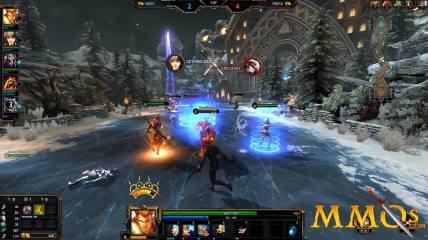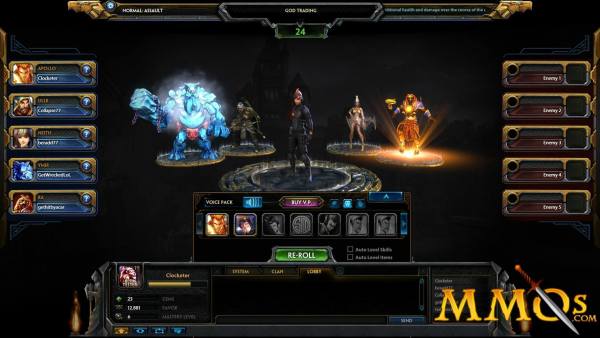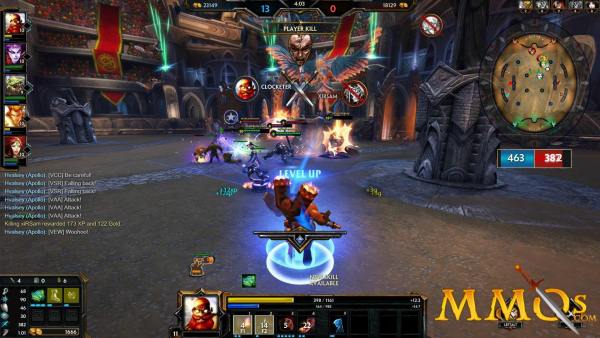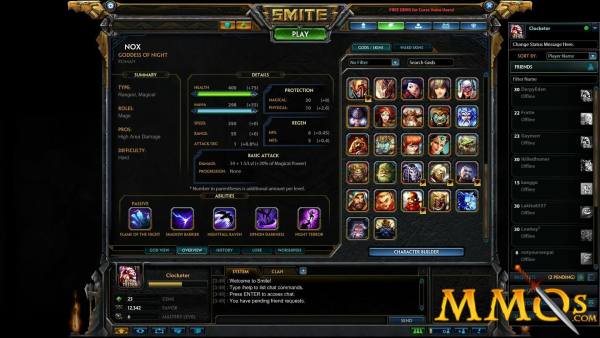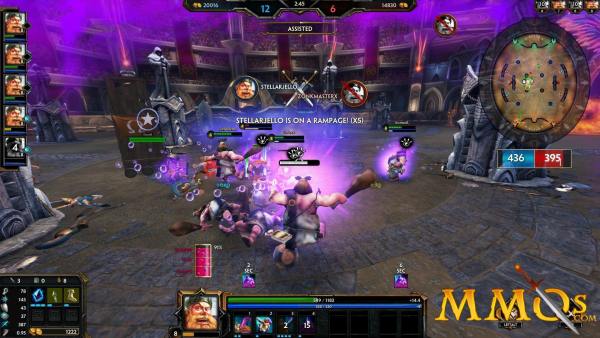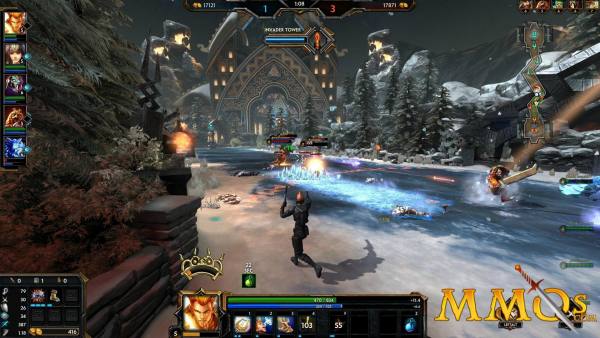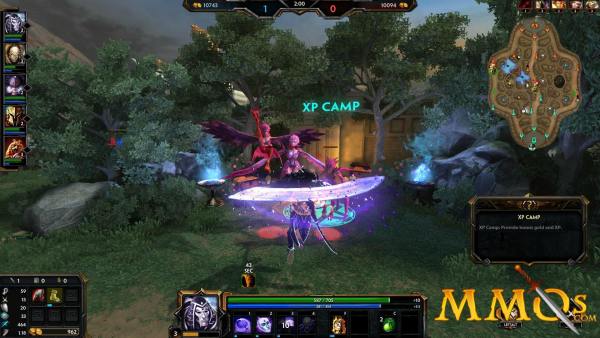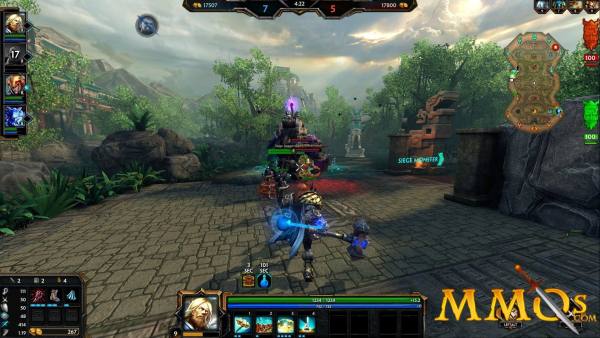Smite
Smite is a 3D fantasy MOBA where players take on the role of mythological gods and battle in team-based arenas. Unlike most games in the genre, Smite has a third person camera view and keyboard controls that put players closer to the action.
| Publisher: Hi-Rez Studios Playerbase: High Type: MOBA Release Date: March 25, 2014 Pros: +Fresh take on the MOBA genre. +Active competitive scene. +Varied game modes and playable Gods. +Balanced cash shop, no gameplay advantages for sale. Cons: -Must unlock new Gods with in-game currency or cashshop. -Steep learning curve. |
Smite Overview
Smite presents the MOBA genre in a whole new perspective. Eschewing the traditional RTS-inspired point-and-click model, players in Smite take direct control of their characters via WASD keyboard controls and a third person camera perspective. This playstyle makes Smite a much more action oriented MOBA where players must manually aim their attacks and skill while strafing oncoming blows. There are currently over 60 playable Gods inspired by various mythologies around the world including Greek, Egyptian, Hindu, Mayan, Norse, and Roman. The basic goal in most of Smite's game modes doesn't stray far from the MOBA formula. Two teams battle their way through waves of NPC minions and towers with the ultimate objective of destroying the opposing faction's main building, in this case a Titan.
Game Modes:
- Conquest – the main 5v5 game mode. Features three lanes and a jungle area filled with neutral monsters.
- Arena – a 5v5 game mode with an open battle area rather than lanes. Each team begins with 500 points and must reduce the other side's to zero by killing heroes, minions, and escorting allied minions to portals.
- Joust – a 3v3 game mode with a single lane which otherwise plays like Conquest mode. Joust can also be played 1v1.
- Assault – similar to ARAM (All Random, All Mid) in LoL, players are assigned a random God and fight on a map with a single lane.
- Siege – a faster version of Conquest. Siege mode consists of only two lanes and contains a special Siege Juggernaut minion that deals extra damage to structures.
- Match of the Day – specialty matches on a daily rotation. Played on a variety of maps with random rule changes such as 'Battle of the Beards,' where only bearded Gods may be selected.
Smite Screenshots
Smite Featured Video
Smite Review
By Huy Luong & Kaneka Chhak
Smite (stylized SMITE) is a free-to-play MOBA developed by Hi-Rez Studios. It was released for Windows on March 25, 2014 with signups for XBox One beta opening January 6, 2015 and has gained fair success despite the overwhelming number of MOBAs that exist in the world. This is likely because Smite offers a unique perspective compared to the standard MOBA. The game features a third person, over-the-shoulder perspective with character movement controlled by the WASD keys, rather than frantic mouse clicking. This not only changes the camera view, but the entire pace and feel of the game. Smite’s mechanics put more emphasis on action than strategizing, and really heighten the feeling of immersion.
Gods and Deities
Smite takes its inspiration from the wide world of mythology; the playable characters are gods, immortals, and creatures from myths across the world. This has lead to some controversy with the belief that portrayal of deities is offensive to its followers, but Hi-Rez declared that its characters represent a diverse pool of mythos and plans to roll out new ones to add to the 60+ ones it already boasts.
Gods come with some customization options, including skins; a purchasable voice pack; and some emotes, such as clapping and waving. The voice pack allows players to communicate with each other by having their god shout out things such as, “Gank!” or “Help!”, which is pretty nifty and would be great for immersion… if the voice acting were a little better. But a lot of the gods’ voices don’t suit them very well, so it’s a bit hit or miss.
Skins include original skins such as Ra’merica and Afro-dite, but most gods also come with a stock-set of Golden, Legendary, and Diamond skins which become available to purchase after gaining worshippers on a god and reaching ranks 1, 5, and 10, respectively.
Reaping Rewards
Playing games nets favor, goodwill, and worshippers. Favor is the in-game currency that allows for purchasing new gods and some skins, as well as renting unowned gods. It can be acquired through a variety of methods, such as playing games, leveling up, and consecutive days of log-in.
Goodwill is the system implemented by Hi-Rez to encourage good behavior among players. For each game completed without negative actions (going AFK, abandoning matches, or being reported), players gain 6% Goodwill, which increases the amount of favor earned from a match.
Worshippers are also acquired through games. For each match played, you gain worshippers for the god used. These build god ranks and increase mastery levels, unlocking avatars and skins for purchase.
Smite also profits with a microtransaction model, with the purchase of Gems. These can be used to unlock gods, skins, and voice packs.
Game Modes
If you’re the type of player to get bored with repetition… Well, maybe MOBAs aren’t the best option for you, but as far as that goes, Smite is a decent one to entertain yourself with. It comes with a hefty variety of game modes, including a Match of the Day, which is a special mode that changes daily. These modes aren’t always stellar – for example, there was a game mode which featured Bacchus, the God of Wine, as the only playable character wherein gameplay was essentially belching and belly-flopping on other players. However, they’re enough to spice things up, and besides, Hi-Rez can’t be too heavily faulted. Who can manage a masterpiece a day?
Aside from the Match of the Day, Smite has five other modes with unique maps. Of those five, four share the standard objective of taking down defensive structures and destroying the central structure of the base, dubbed Titan in this game.
Conquest is the typical MOBA mode that comes with the expected elements: a 5v5 map with two bases at opposite ends of the map with three lanes to connect them and a jungle between the lanes. Lanes are protected by two towers and a phoenix. These are both defensive structures which deal physical damage, but phoenixes also serve as inhibitors; destroying one will spawn stronger minions in that lane.
Joust is a simpler version of Conquest; it is a 3v3 with only one lane enclosed in jungle. Players start at level 3 in this mode to speed things along and compensate for the smaller map by placing more focus on combat. There is also Siege, a 4v4 with two lanes and a moderately sized jungle. Like Joust, Siege starts players at level 3, but distinguishes itself with a creature known as the Juggernaut. The names of the game modes are indicative of the play-style. With only one lane, Joust emphasizes jousting, or combat, whereas Siege is more concerned with pushing lanes, and brings in the Siege Juggernaut to help teams do so.
There is also Assualt, a 5v5 in which players are given random gods. Much like League of Legend’s ARAM, there is only one lane, with no jungle, and an inability to back for health regen or item-purchase until death. However, Assualt comes with a balancing mechanic built in such that either both teams have a god with a heal or neither does, eliminating the sinking feeling when the enemy has sustain for days.
Finally, there is the Arena mode, which differs most from the cut-and-dry MOBA blueprint. There is no Titan in this game mode, and no lanes. The map of Arena is just that, a 5v5 arena in which teams start with 500 points and compete to lower the enemy to zero first. Points are taken by killing enemy gods, last hitting minions, and escorting minions/siege towers to the enemy portal, but usually just becomes a kick-ass deathmatch, and once again, you are all out of ass.
There’s also something there for the super l33t. Like most MOBAs, Smite also has a ranked system which can be played on two maps: Conquest and Joust. The ranked system is known as the League, and goes from Bronze to Master. Each season is divided into several two-month rounds, in which players can receive rewards in the form of shiny icons and badges. The professional scene is growing, with teams from across the world competing for a huge prize pool.
Gameplay
As mentioned before, Smite offers a change in perspective to other MOBAs. This cannot be overstated, as it is easily the most interesting aspect of the game. And yes, it does make a huge difference. Positioning is even more important (and for casual MOBA players, fear not, it actually feels important, too) because you have to be where you can hit the enemy gods-- you, the god, not you-the-person controlling the god. You have to aim all your attacks and abilities, and rushing in and out of combat is quite the… rush.
All joking aside, the third person perspective really puts an exciting spin on things. At times, Smite feels more like an action RPG than a MOBA. The WASD movement is simultaneously intuitive and fresh. Towers tower over you, as do phoenixes, titans, and large jungle creep. Aerial abilities don’t just give your character sprite a shadow or some particle effects, but actually let you soar above the map.
Speaking of which, the new angle changes the game in another crucial way: map awareness. Without the overhead view, it becomes a lot easier to fall victim to heartless ganks. At the same time, that means it’s also easier to sneak up on opponents, which encourages players to roam more and gives the somewhat tedious laning phase a more dynamic flow. Besides, wandering around the jingle-jangle-jungle is exciting. The Smite jungle is pretty expansive with multiple neutral camps with buffs for speed, damage, and mana regen, as well as larger camps in Conquest that give global gold or team buffs. It can be a bit maze-like at times, especially when looking at the paths and bushes from behind your character instead of above, but that also adds an element of danger. While you face a jungle monster that actually manages to look threatening with the new angle, you open yourself to enemy ambush.
Itemization and Abilities
There are three types of items in Smite: actives, passives, and consumables, with each class getting its own slots. Unlike in many other MOBAs, where items combine to build into higher tier items, Smite’s items just upgrade along three tiers. Actives are an interesting mechanic in the game, similar to that of “Summoner Spells” in League of Legends and can do things such as making you immune to crowd control, or ‘blinking’ you into the middle of the enemy team to initiate. Consumables, along with the standard wards or health/mana potions, can give temporary buffs.
Most gods have four distinct abilities, with their ultimate becoming available at level five, but some ultimates change the functionality of the other skills, essentially giving six different ones with skillful animation and particle effects. You cannot generalize and categorize the abilities. They are very unique and have mechanics of their own.
Smite also contains a autobuy/autolevel feature. This feature automatically levels your abilities and buys you items accordingly to your character, which is a great way for beginners to get into the game. However, it is also great for lazy people like me or for when you get swept up in the action, because the autobuy/autolevel sheets can be customized or toggled on and off whenever.
Final Verdict - Great
Those familiar with MOBAs should definitely give Smite a try. Some may even like Smite’s third person gameplay more than the traditional MOBA. Smite brings in a fresh take on the MOBA scene, along with riveting gods and beautiful particle effects. There is also a pretty dedicated eSports scene. There are many tournaments with big cash prizes, so competition is definitely there if that’s what you fancy.
Queue times can be a little frustrating though, and while we enjoy playing while we’re in game, somehow Smite usually gets forgotten after a while. However, you should definitely give it a try. You may find one of your favorite gods, learn some mythology, or start thinking of deities in a whole new light (I’m looking at you, Dominatrix Bastet). And as always, everything is more fun with friends.
Smite Videos
Smite Links
Smite Official Website
Smite Gamepedia (Database / Guides)
Smite Wikipedia Page
Smite Subreddit
SmiteFire (Smite Guides / News)
Smite System Requirements
Minimum Requirements:
Operating System: Windows XP SP2 / Vista / 7
CPU: Intel Core 2 Duo 2.4 GHz / AMD Athlon 64 X2 2.7 GHz
Video Card: Nvidia GeForce 8800 GT / ATI Radeon 3870
RAM: 2 GB
Hard Disk Space: 10 GB
Recommended Requirements:
Operating System: Windows 7 / 8
CPU: Intel Core i5 750 2.67 GHz / AMD Phenom II X4 965 3.4 GHz or better
Video Card: Nvidia GeForce GTX 560 / ATI Radeon 6950 or better
RAM: 4 GB or better
Hard Disk Space: 10 GB
Smite Music & Soundtrack
Smite Additional Information
Developer: Hi-Rez Studios
Executive Producer: Chris Larson
Art Director: Thomas Holt
Composer: Chris Rickwood
Other Platforms: Windows / Xbox One / Playstation 4
Game Engine(s): Unreal Engine 3
Closed Beta Date: May 31, 2012 - January 23, 2012
Open Beta Date: January 24, 2012 - March 24, 2014
Playstation 4 Release Date: March 22, 2016 (Open beta)
Foreign Publishers:
China: Tencent
Latin America: Level Up! Games
Development History / Background:
Smite was developed by Alpharetta, Georgia-based Hi-Rez studios. Development for Smite began in 2010 and the game was originally announced at PAX East on April 21, 2011. The game's first round of closed beta testing began on May 31 and the game saw immediate success. Hi-Rez Studios' CEO, Eren Goren, explained that Smite was the only game developed by Hi-Rez that was profitable, even during beta. Smite is powered by the Unreal 3 Engine. The game's development team exploded from an initial 15 during closed beta, to 80 after open beta, and 175+ upon commercial release on March 24, 2014.
